Iran Diabetes Care Devices Market Size
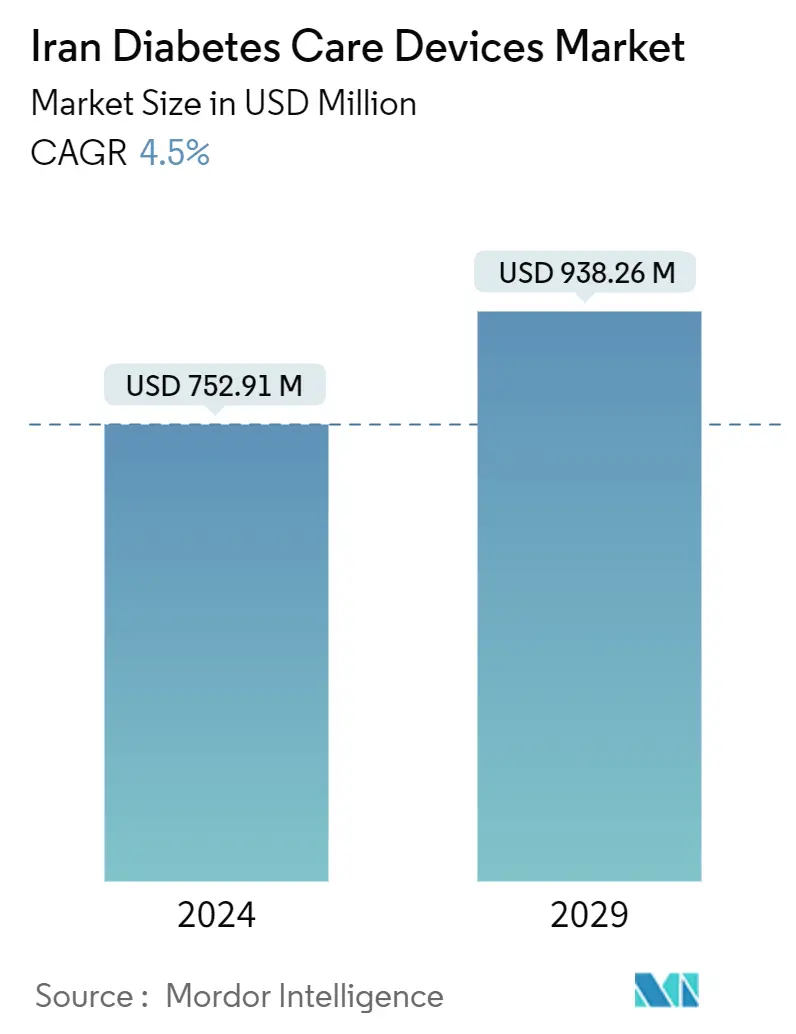
| Study Period | 2019 - 2029 |
| Base Year For Estimation | 2023 |
| Forecast Data Period | 2024 - 2029 |
| Market Size (2024) | USD 752.91 Million |
| Market Size (2029) | USD 938.26 Million |
| CAGR (2024 - 2029) | 4.50 % |
Major Players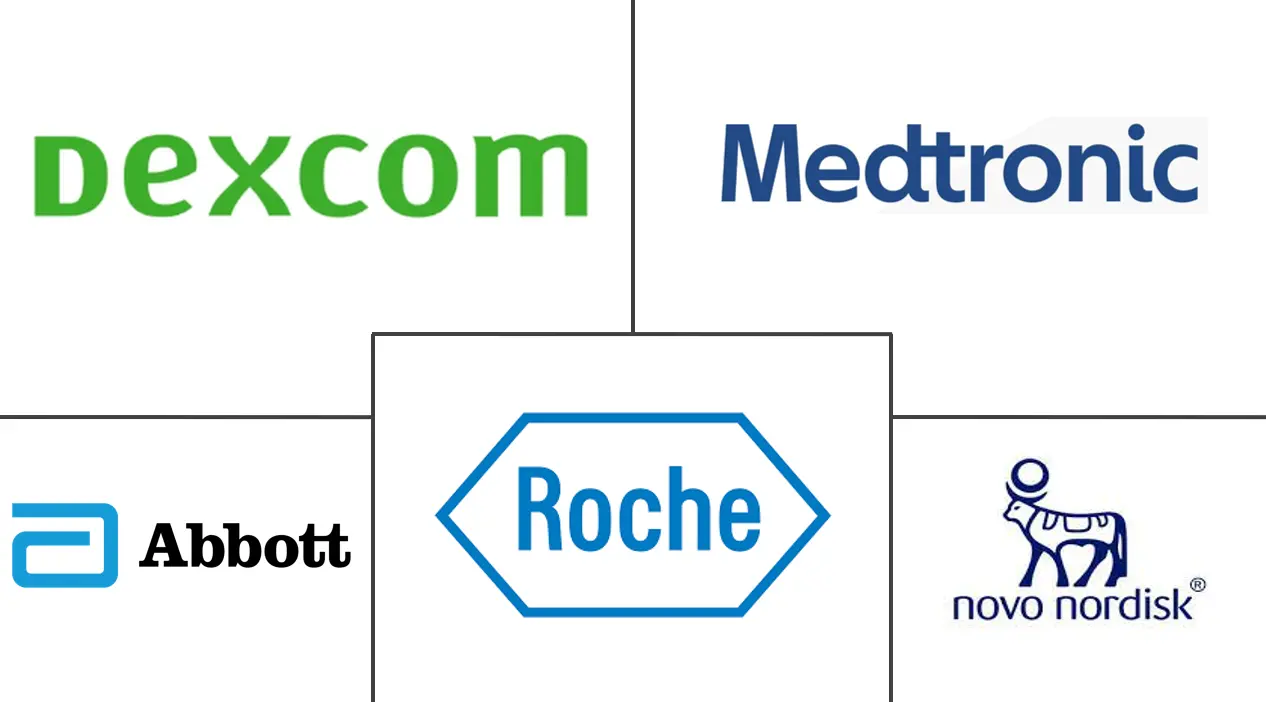
*Disclaimer: Major Players sorted in no particular order |
Iran Diabetes Care Devices Market Analysis
The Iran Diabetes Care Devices Market size is estimated at USD 752.91 million in 2024, and is expected to reach USD 938.26 million by 2029, growing at a CAGR of 4.5% during the forecast period (2024-2029).
The most significant challenges of diabetes care management in developing countries during the COVID-19 pandemic include inadequate preventive measures, interrupted traditional methods of relationship with the patient, medication shortages, disruption of routine diabetic care, and a lack of the necessary infrastructure for telehealth services. Diabetes prevalence is increasing in Iran, as in many other nations. In addition to the problems inherent in diabetes management in impoverished nations, Iran has encountered new hurdles in the last two years as sanctions have tightened. During the COVID-19 crisis in Iran, the weight of sanctions more than quadrupled.
The most important components of diabetes self-management that should be considered to control hyperglycemia better and prevent or at least delay complications in diabetic patients are regular blood glucose monitoring, following a healthy diet, regular physical activity, and compliance with medication and foot care. Shortages or the high prices of devices such as insulin pens escalated the anxiety of patients with diabetes and complicated the management of their disease during the COVID-19 crisis.
Iran Diabetes Care Devices Market Trends
Management Devices Hold Highest Market Share in Iran Diabetes Care Devices Market
Type 1 diabetes (T1D) patients must maintain good lifestyle conditions influenced by a person's personality qualities, social interactions, socioeconomic situations, and environmental living variables. Continuous glucose monitoring (CGM) combined with multiple daily injections (MDI) has been demonstrated to reduce nonsevere and severe hypoglycemia in persons with T1D prone to this side event. Patients with T1D at high risk of hypoglycemia can employ standalone continuous glucose monitoring to regulate their blood sugar levels even in the terrible living conditions imposed by the COVID-19 pandemic crisis's draconian lockdown.
Diabetes patients in Iran face financial hardship. Pharmacies do not sell enough insulin to people with diabetes; instead, insulin is sold at a higher price on the open market. Sometimes the parent of a diabetic child is unable to locate insulin. Insulin costs 20-30% of a family's monthly income for children and adults with type 1 diabetes. This does not include the cost of test strips and other supplies, which are extremely costly. Furthermore, insurance companies in Iran are reducing financial support for diabetic treatments. The availability of insulin is restricted, and Iranian families with diabetic children cope by reducing the number of carbohydrates in their child's diet.
Despite all these, in Iran, usage of Insulin management devices increasing over the years.
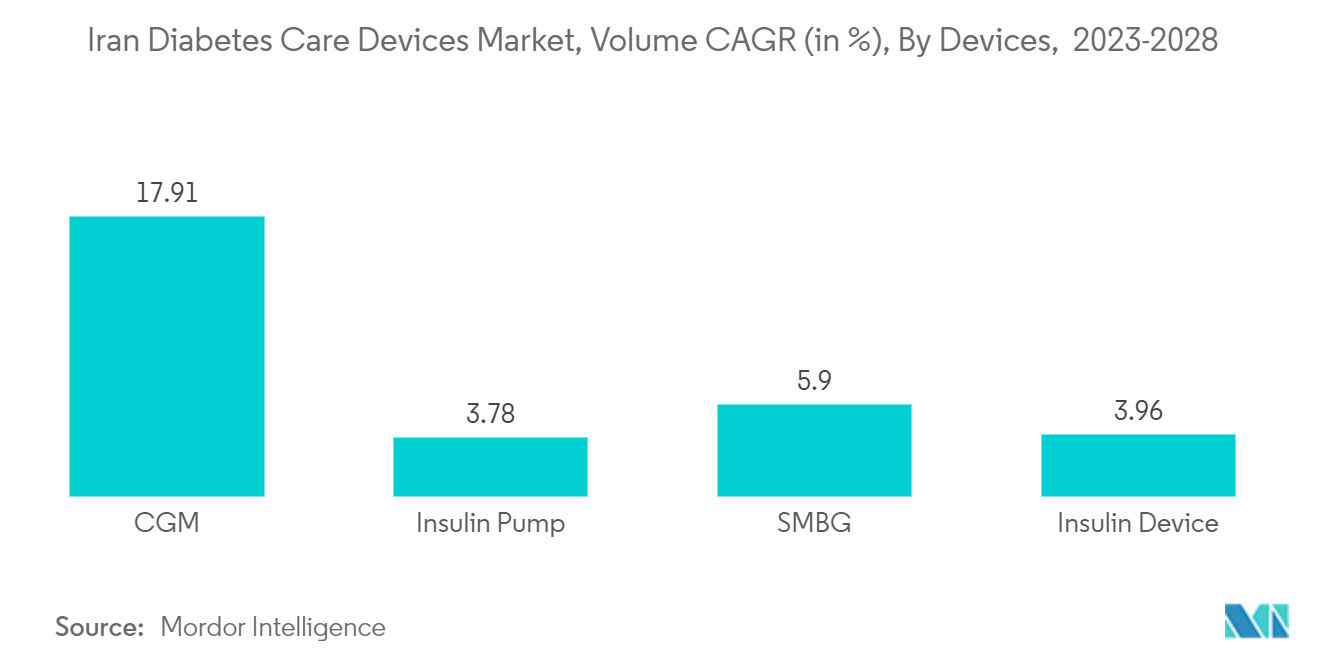
Increasing Type -1 Diabetes Population in Iran
Diabetes is a serious public health concern in Iran, the Middle East's second-largest country, due to its high prevalence rate, growing occurrence rate, and economic impact. It is estimated that by the year 2030, 9.2 million Iranian individuals will have diabetes. Diabetes-related mortality in Iran continues to rise; the age-standardized death rate from diabetes has risen. Diabetes has significant economic consequences in the country. Diabetes and its high direct healthcare costs are significant risk factors for chronic illnesses like cardiovascular disease.
Diabetes complications, for example, accounted for USD 412 (49%) of the USD 843 per capita cost of diabetes. Yazd, a world heritage city in the center of Iran, has one of the highest recorded prevalences of DM in Iran. Other cities in Iran have varying levels of DM awareness. For example, in Kerman, a province south of Yazd, the prevalence of undiagnosed diabetes is only 2.7%, but it is 25% in northern Iran.
Despite the widespread availability of drugs and insulin coverage in Iran, the estimated national control of hyperglycemia, hyperlipidemia, and hypertension (particularly among young men and women) remains inadequate.
As a result, Iran's diabetes care devices market is predicted to expand gradually in the coming years.
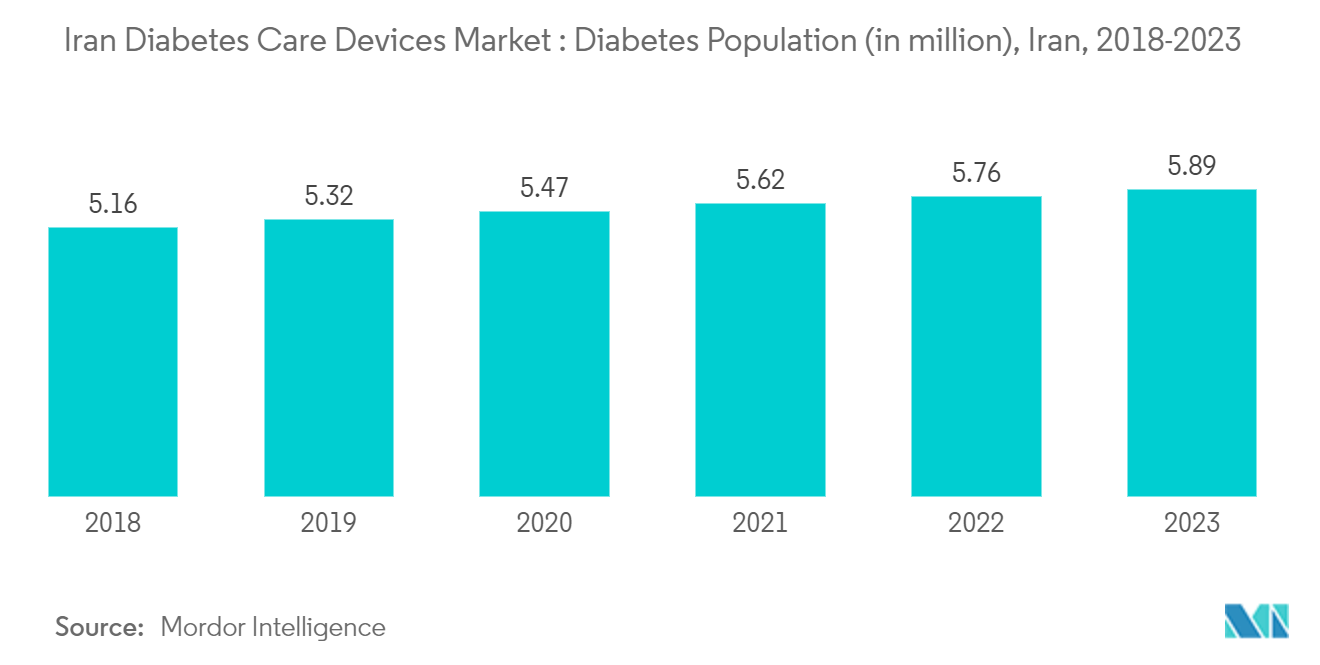
Iran Diabetes Care Devices Industry Overview
The new technologies in diabetes devices, like continuous glucose monitoring, increased the market for monitoring devices. The mergers and acquisitions between the players, like the acquisition of TypeZero Technologies by Dexcom, are paving the way for automated insulin delivery. The acquisition has sent Dexcom ahead on its way in the race to create an artificial pancreas system rather than merely offering a boost to the continuous glucose monitoring devices market.
Iran Diabetes Care Devices Market Leaders
-
Medtronic
-
Roche
-
NovoNordisk
-
Abbott
-
Dexcom
*Disclaimer: Major Players sorted in no particular order
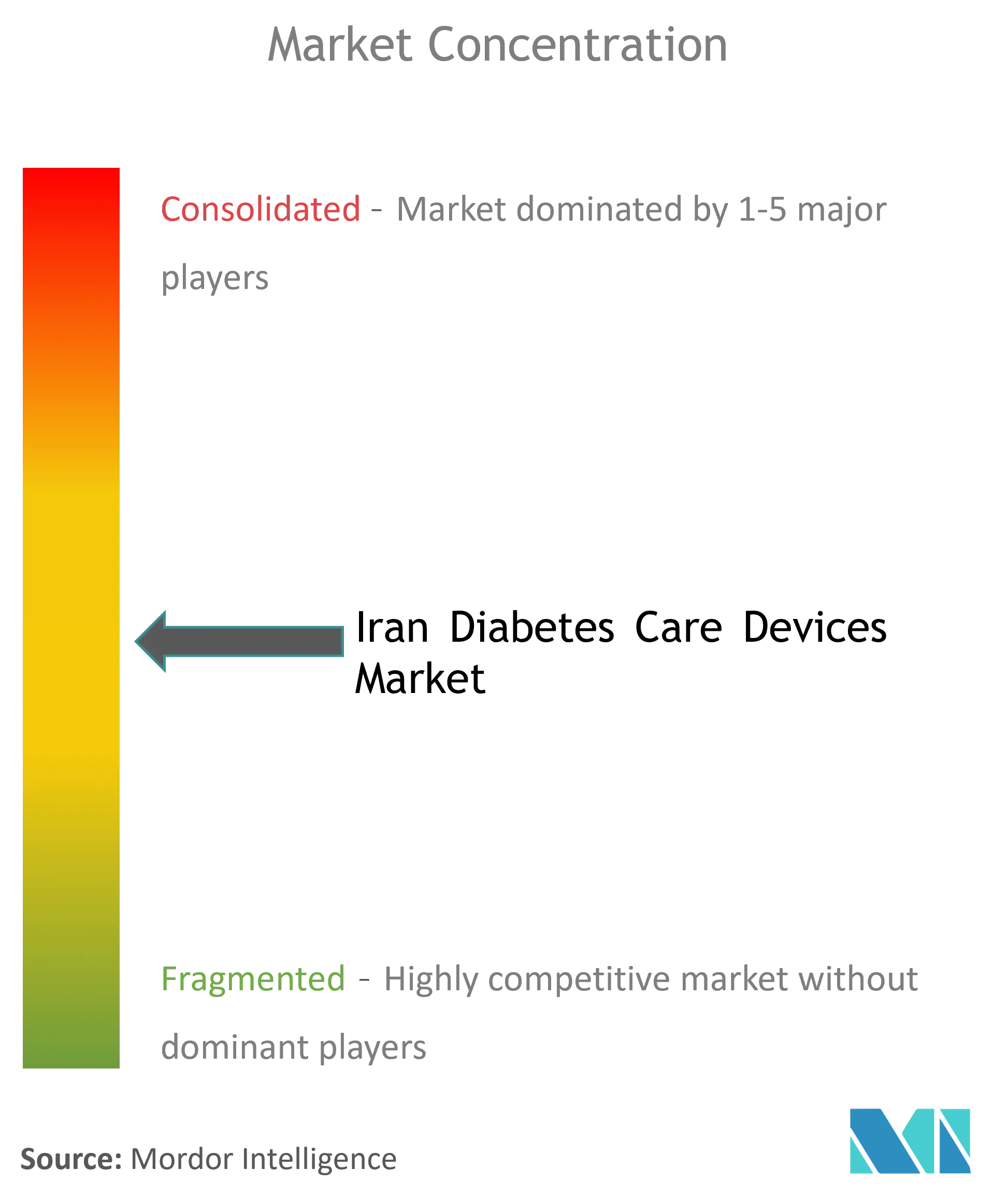
Iran Diabetes Care Devices Market News
- April 2023: Medtronic plc has recently received approval from the U.S. Food and Drug Administration (FDA) for its MiniMed 780G system, which incorporates the Guardian 4 sensor and utilizes SmartGuard technology. Notably, this advanced system eliminates the need for fingersticks.
- February 2022: Drug firm Abbott announced it has tied up with various health-tech firms like BeatO, and Sugar.fit, PharmEasy, GOQii, 1MG, and Zyla for diabetes care. The company has also joined hands with Health, HealthifyMe, and Fitterfly under the initiative.
Iran Diabetes Care Devices Market Report - Table of Contents
1. INTRODUCTION
- 1.1 Study Assumptions and Market Definition
- 1.2 Scope of the Study
2. RESEARCH METHODOLOGY
3. EXECUTIVE SUMMARY
4. MARKET DYNAMICS
- 4.1 Market Overview
- 4.2 Market Drivers
- 4.3 Market Restraints
-
4.4 Industry Attractiveness - Porter's Five Forces Analysis
- 4.4.1 Threat of New Entrants
- 4.4.2 Bargaining Power of Buyers/Consumers
- 4.4.3 Bargaining Power of Suppliers
- 4.4.4 Threat of Substitute Products
- 4.4.5 Intensity of Competitive Rivalry
5. MARKET SEGMENTATION
-
5.1 Monitoring Devices
- 5.1.1 Self-monitoring Blood Glucose Devices
- 5.1.1.1 Glucometer Devices
- 5.1.1.2 Test Strips
- 5.1.1.3 Lancets
- 5.1.2 Continuous Blood Glucose Monitoring
- 5.1.2.1 Sensors
- 5.1.2.2 Durables
-
5.2 Management Devices
- 5.2.1 Insulin Pump
- 5.2.1.1 Insulin Pump Device
- 5.2.1.2 Insulin Pump Reservoir
- 5.2.1.3 Infusion Set
- 5.2.2 Insulin Syringes
- 5.2.3 Insulin Cartridges
- 5.2.4 Disposable Pens
6. MARKET INDICATORS
- 6.1 Type-1 Diabetes population
- 6.2 Type-2 Diabetes population
7. COMPETITIVE LANDSCAPE
-
7.1 Company Profiles
- 7.1.1 Becton and Dickenson
- 7.1.2 Medtronic
- 7.1.3 Insulet
- 7.1.4 Tandem
- 7.1.5 Ypsomed
- 7.1.6 Novo Nordisk
- 7.1.7 Sanofi
- 7.1.8 Eli Lilly
- 7.1.9 Abbottt
- 7.1.10 Roche
- 7.1.11 Lifescan (Johnson &Johnson)
- 7.1.12 Dexcom
- *List Not Exhaustive
- 7.2 Company Share Analysis
8. MARKET OPPORTUNITIES AND FUTURE TRENDS
** Subject To AvailablityIran Diabetes Care Devices Industry Segmentation
CGM devices consist of three essential components: a sensor, a transmitter, and a receiver or monitor. The sensor, a compact device, is gently inserted beneath the skin to continuously monitor blood sugar levels, providing real-time measurements multiple times per minute. Subsequently, the transmitter relays this valuable information to a receiver, which can either be integrated into an insulin pump or exist as a standalone device. Iran diabetes care devices market is segmented into devices (management devices (insulin pumps, insulin pens, syringes, cartridges, and jet injectors) and monitoring devices (self-monitoring blood and continuous glucose monitoring)). The report offers the market size in value terms in USD and volume terms in units for all the abovementioned segments.
| Monitoring Devices | Self-monitoring Blood Glucose Devices | Glucometer Devices |
| Test Strips | ||
| Lancets | ||
| Monitoring Devices | Continuous Blood Glucose Monitoring | Sensors |
| Durables | ||
| Management Devices | Insulin Pump | Insulin Pump Device |
| Insulin Pump Reservoir | ||
| Infusion Set | ||
| Management Devices | Insulin Syringes | |
| Insulin Cartridges | ||
| Disposable Pens |
Iran Diabetes Care Devices Market Research FAQs
How big is the Iran Diabetes Care Devices Market?
The Iran Diabetes Care Devices Market size is expected to reach USD 752.91 million in 2024 and grow at a CAGR of 4.5% to reach USD 938.26 million by 2029.
What is the current Iran Diabetes Care Devices Market size?
In 2024, the Iran Diabetes Care Devices Market size is expected to reach USD 752.91 million.
Who are the key players in Iran Diabetes Care Devices Market?
Medtronic, Roche, NovoNordisk, Abbott and Dexcom are the major companies operating in the Iran Diabetes Care Devices Market.
What years does this Iran Diabetes Care Devices Market cover, and what was the market size in 2023?
In 2023, the Iran Diabetes Care Devices Market size was estimated at USD 719.03 million. The report covers the Iran Diabetes Care Devices Market historical market size for years: 2019, 2020, 2021, 2022 and 2023. The report also forecasts the Iran Diabetes Care Devices Market size for years: 2024, 2025, 2026, 2027, 2028 and 2029.
Iran Diabetes Care Devices Industry Report
Statistics for the 2024 Iran Diabetes Care Devices market share, size and revenue growth rate, created by Mordor Intelligence™ Industry Reports. Iran Diabetes Care Devices analysis includes a market forecast outlook 2029 and historical overview. Get a sample of this industry analysis as a free report PDF download.



